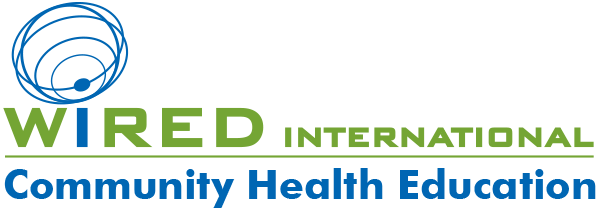By Allison Kozicharow; Edited by Elizabeth Fine
Introduction
 WiRED International’s paraprofessional team of community health workers (CHWs) press on with their crucial monthly work of caring for the health of their populations in Kisumu, Kenya. Their role is more critical than ever now that few medicines and zero vaccines are available to treat disease because of USAID cuts to global health funding.
WiRED International’s paraprofessional team of community health workers (CHWs) press on with their crucial monthly work of caring for the health of their populations in Kisumu, Kenya. Their role is more critical than ever now that few medicines and zero vaccines are available to treat disease because of USAID cuts to global health funding.
 In a recent WiRED web story we reported that Gavi, the Vaccine Alliance issued a potential epidemic warning for three infectious diseases: malaria, HIV and tuberculosis (TB). This April WiRED CHWs in Kenya served 8,324 people in their communities and the top health issues were malaria, HIV/AIDS, mental health and TB (see sidebar). Although these illnesses are already endemic to low-resource countries such as Kenya, the Gavi-listed diseases are expected to uptick in communities such as Kisumu.
In a recent WiRED web story we reported that Gavi, the Vaccine Alliance issued a potential epidemic warning for three infectious diseases: malaria, HIV and tuberculosis (TB). This April WiRED CHWs in Kenya served 8,324 people in their communities and the top health issues were malaria, HIV/AIDS, mental health and TB (see sidebar). Although these illnesses are already endemic to low-resource countries such as Kenya, the Gavi-listed diseases are expected to uptick in communities such as Kisumu.
Outcomes
WiRED initiated a new reporting system for our CHWs last month. The new outcomes procedure will record data on CHW home visits, referrals and follow-up and help us understand the direct interventions and level of care CHWs provide. The following include sample outcomes for April.
Malaria
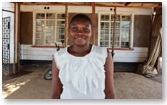 Community health education has impacted the lives of people in my community. Malaria has been a menace in Kisumu because of poor sanitation — the buildup of standing, contaminated water— and this has led to young children and even infants being infected by malaria. I have managed to do various outreach in relation to malaria management and prevention. One of my neighbors had a three-year-old child who had symptoms and signs of malaria. He was given medication and the boy is well. The community has also managed to embrace good practices like using mosquito nets, slashing brush and unclogging stagnant water around the homestead.
Community health education has impacted the lives of people in my community. Malaria has been a menace in Kisumu because of poor sanitation — the buildup of standing, contaminated water— and this has led to young children and even infants being infected by malaria. I have managed to do various outreach in relation to malaria management and prevention. One of my neighbors had a three-year-old child who had symptoms and signs of malaria. He was given medication and the boy is well. The community has also managed to embrace good practices like using mosquito nets, slashing brush and unclogging stagnant water around the homestead.
—CHW Linet Awuor
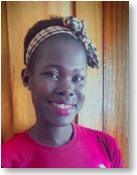 During a community health class I came across a mother who complained that her child has been suffering from malaria on and off.* I educated her on the preventive measures of malaria: put the child to sleep under an insecticide-treated mosquito net, slash the bush and burn the compound and draw all the stagnant water around. I told the mother to take the child for more diagnosis and get proper treatment. She must adhere to drug instructions, provide good nutrition and offer only treated water for drinking. She then thanked me and the WiRED organization for good information that saved her baby.
During a community health class I came across a mother who complained that her child has been suffering from malaria on and off.* I educated her on the preventive measures of malaria: put the child to sleep under an insecticide-treated mosquito net, slash the bush and burn the compound and draw all the stagnant water around. I told the mother to take the child for more diagnosis and get proper treatment. She must adhere to drug instructions, provide good nutrition and offer only treated water for drinking. She then thanked me and the WiRED organization for good information that saved her baby.
—CHW Carren Osomo
*Editor’s note: Malaria is typically characterized by the “coming and going” of symptoms. This is because of the parasite’s complex life cycle involving stages of multiplication in the liver (without symptoms) followed by cyclical asexual reproduction and rupture in the red blood cells, triggering the periodic fever, chills, and sweating characteristic of the disease. (For more info, click here and here.)
HIV/AIDS

The people in the community, especially the ones affected with HIV/AIDS are worried because of the shortage of drugs. Some people have lost hope and stated that without the drugs their immune system will be lowered and they will die of AIDS. In addition to the lack of HIV/AIDS medicine, women are worried about the birth control methods that might not be there and also vaccines for their newborns. They plead with WIRED to continue with outreach to save lives as they also call upon additional services such as family planning methods to be introduced during the outreaches.
—CHW Tracy Agatha
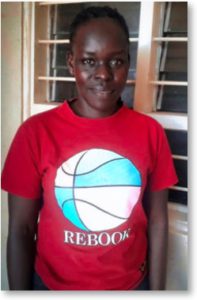 As I was doing health education in different villages, I came across a certain lady who has been sick for about one month and had not gone to the hospital for a medical checkup. She waited till I finished giving a health education class, and then came to me and explained that her symptoms included loss of appetite and weight loss and that she was becoming thinner every day. I talked with her, counseled her and referred her to the nearest health facility. There she tested HIV+ and was introduced to antiretroviral therapy medicine [which was still available at that time]. I followed up with her two weeks later. She was very grateful for the good work CHWs are doing in the community.
As I was doing health education in different villages, I came across a certain lady who has been sick for about one month and had not gone to the hospital for a medical checkup. She waited till I finished giving a health education class, and then came to me and explained that her symptoms included loss of appetite and weight loss and that she was becoming thinner every day. I talked with her, counseled her and referred her to the nearest health facility. There she tested HIV+ and was introduced to antiretroviral therapy medicine [which was still available at that time]. I followed up with her two weeks later. She was very grateful for the good work CHWs are doing in the community.
—CHW Millicent Randiki
Tuberculosis
 Going back to my CHW work in 2023, I came across a man who was very sick, had no appetite and was coughing terribly. He could not even walk since he was so weak. I referred him to the healthcare provider where he was taken to laboratory for further diagnosis and when the results came out it was found out that he had TB. He was then put on TB drugs. I practiced directly observed therapy, which means I observed him daily to make sure he took his medicine daily. He gained weight within six months. By last year November 2024 the man was doing well. This has been a lesson to other community members that TB has a cure and you can still have a normal life as long as you adhere to drugs without defaulting. Since then, today, the man is very healthy and living happily without any stress.
Going back to my CHW work in 2023, I came across a man who was very sick, had no appetite and was coughing terribly. He could not even walk since he was so weak. I referred him to the healthcare provider where he was taken to laboratory for further diagnosis and when the results came out it was found out that he had TB. He was then put on TB drugs. I practiced directly observed therapy, which means I observed him daily to make sure he took his medicine daily. He gained weight within six months. By last year November 2024 the man was doing well. This has been a lesson to other community members that TB has a cure and you can still have a normal life as long as you adhere to drugs without defaulting. Since then, today, the man is very healthy and living happily without any stress.
—CHW Millicent Randiki

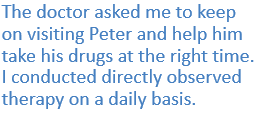 I came across a certain man by the name of Peter who was diagnosed with TB on March 2021. He was very sick, had no appetite, he was coughing and was even afraid to sit in on any CHW meetings for the community. I asked him if he had been attended to by any doctor or if he had visited any hospital in the previous years, to which he said yes. I insisted that he get referred again to the healthcare provider for further diagnosis. I called a doctor at the clinic and shared with him about Peter’s health. The doctor told me to bring him in so that he could assess him. Peter turned out to still have TB. He received TB drugs and was advised to return to the doctor and continue drug treatment. The doctor asked me to keep on visiting Peter and help him take his drugs at the right time. I conducted directly observed therapy on a daily basis. Peter’s health started to improve. After taking drugs for six months, Peter came to community meetings and gave his contributions. Community members now can learn about TB from Peter.
I came across a certain man by the name of Peter who was diagnosed with TB on March 2021. He was very sick, had no appetite, he was coughing and was even afraid to sit in on any CHW meetings for the community. I asked him if he had been attended to by any doctor or if he had visited any hospital in the previous years, to which he said yes. I insisted that he get referred again to the healthcare provider for further diagnosis. I called a doctor at the clinic and shared with him about Peter’s health. The doctor told me to bring him in so that he could assess him. Peter turned out to still have TB. He received TB drugs and was advised to return to the doctor and continue drug treatment. The doctor asked me to keep on visiting Peter and help him take his drugs at the right time. I conducted directly observed therapy on a daily basis. Peter’s health started to improve. After taking drugs for six months, Peter came to community meetings and gave his contributions. Community members now can learn about TB from Peter.
—CHW Daniel Ayieko
Conclusion
Outcome Report from Lillian Dajoh, WiRED’s CHW Program Director in Kisumu
 Our community has been receiving health education from the CHWs on different health issues and also learning life skills. This education has helped the community to effect a positive change in the following areas:
Our community has been receiving health education from the CHWs on different health issues and also learning life skills. This education has helped the community to effect a positive change in the following areas:
- Malaria
Malaria cases have gone down due to the fact that the community is getting information on malaria preventive measures, which includes sleeping under treated mosquito nets, slashing brush and keeping the compound clean, draining all the stagnant waters and children having been vaccinated against malaria. - Cholera
Cholera cases have decreased due to the information and education given to the community members on the importance of water treatment using chlorine or by boiling it before drinking and making sure that the vessel that is used to store water is clean. - HIV/AIDS
 HIV/AIDS surveillance has helped many people in the community because awareness and measures have helped to reduce cases and stigma. Nowadays people can open up about their status without being judged or afraid of what people are going to talk about when it comes to their health. Health facilities have also played a big role by doing follow-up and carrying out reminder activities for the drugs to be taken by the affected individuals. WiRED outreaches are valued in the community for doing a good job in testing for HIV, doing counseling and making referrals. CHWs teach disease prevention measures, abstinence and the use of condoms. Those who test positive for HIV need to practice good adherence to drugs, if any are available. Gaining these skills and information as well as education has made the community members better able to take good care of themselves.
HIV/AIDS surveillance has helped many people in the community because awareness and measures have helped to reduce cases and stigma. Nowadays people can open up about their status without being judged or afraid of what people are going to talk about when it comes to their health. Health facilities have also played a big role by doing follow-up and carrying out reminder activities for the drugs to be taken by the affected individuals. WiRED outreaches are valued in the community for doing a good job in testing for HIV, doing counseling and making referrals. CHWs teach disease prevention measures, abstinence and the use of condoms. Those who test positive for HIV need to practice good adherence to drugs, if any are available. Gaining these skills and information as well as education has made the community members better able to take good care of themselves.
Clearly, CHWs in Kisumu continue to protect and educate their community members and provide the best possible care under challenging circumstances exacerbated by supply chain deprivation.
The following list is all in a day’s work for WiRED’s 20-member paraprofessional CHW team. Their work includes:
- Hosting group sessions about disease awareness, prevention and treatment
- Talking one-on-one with people
- Screening for illnesses
- Treating common complaints
- Providing simple medications to ease pain in the midst of stoppage of health funding programs, especially from the United States
- Performing home visits and offering home care
- Making referrals to clinics as needed
- Following up with patients
- Accessing WiRED’s library of health modules through our apps (Android app and Apple)
- Taking WiRED-required continuing medical education to remain up to date with their skills.
April CHW Report
During the month of April 2025, 20 CHWs in Kisumu, Kenya, reached a total of 8,324 people with health services. Working 24 hours per week, each of the CHWs met with at least 24 patients a week, and the largest number seen in a week by a single CHW was 262, most of them in health training classes. Top health topics of concerns for the month of March in order of prevalence are:
- Malaria, #1 by far
- HIV/AIDS
- Mental health
- TB
- Cholera
- Family planning
- Nutrition

